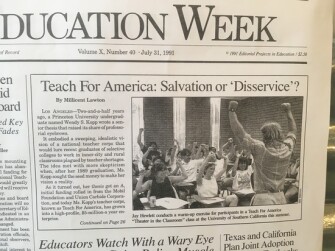
Here at Education Week, one of our executive editor’s fun quirks is his habit of putting the front page of the newspaper from 25 years ago up in the staff kitchen. Last week’s, from July 1991, caught my eye, and I’ve put a photo of it above.
“Salvation or Disservice?” the headline asks provocatively. It goes on to explore questions about whether TFA’s recruits are underprepared and whether its approach is destabilizing teaching—and includes a quote from Linda Darling-Hammond, who would go on to write a scathing indictment of the group in 1994. (You can read the entire story here in our archives.)
Today, of course, many of those same themes continue to surface in overage of TFA. Yet I’m also struck, on reading this, by how different the context is today.
TFA only had 750 corps members in 1991, compared with more than 8,000 a year it has now. It was much, much less politically powerful. At that time, it didn’t use a teaching framework and its preparation lasted eight weeks, not five. There was far less classroom coaching. Because it was so new, TFA didn’t have much to show for its theory of action about developing leaders. Alternative teaching programs were brand new in 1991; there are hundreds of them now.
Earlier this year, I reported out a series of stories about TFA’s lastest evolution, much of which concerns its decentralization. One of my conclusions was that it’s unclear what the group is going to look like in the future.
And in the few short months since the story ran, TFA’s recruitment process is changing again, putting more emphasis on regional “fit” and ditching a telephone interview with an alumnus as part of the process.
Put another way, the headlines may be the same, but that the internal dynamics of the organization (as well as its wider impact) have changed dramatically. And so I pose the question: in another 25 years, what will TFA headlines will say?
See also:
- At 25, Teach For America Enters Period of Change
- Outside the Classroom, TFA Leaves Complex Political Trail
